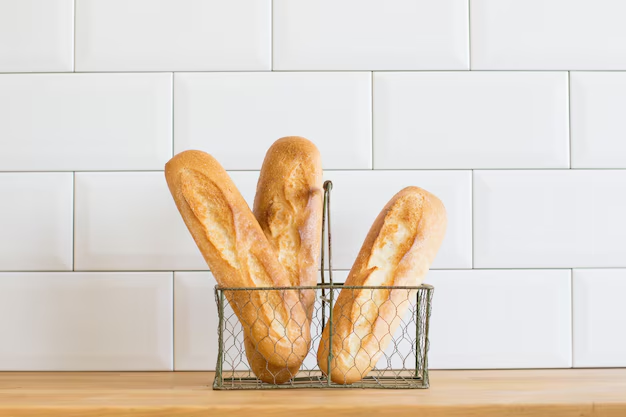Should You Keep Bread in the Refrigerator? A Comprehensive Guide on Bread Storage
For many, bread is a pantry staple with an irreplaceable spot on the breakfast table, at lunch, and even at dinner. But a common debate persists in kitchens across the globe: is it good to keep bread in the refrigerator? This guide explores the many facets of bread storage, providing you with the insights needed to make the best choice for keeping your bread fresh.
🥖 The Nature of Bread: Understanding Its Shelflife
Before diving into storage methods, it's crucial to understand what makes bread go stale. Freshly baked bread is loved for its soft, airy texture and crispy crust. However, once cut and exposed to air, its shelf life quickly diminishes.
Why Does Bread Go Stale?
Starch Retrogradation: Bread's primary ingredient, starch, undergoes a process called retrogradation, where it crystallizes and hardens over time. This process accelerates in cooler temperatures, such as those in a refrigerator.
Moisture Loss: Bread becomes stiffer as it loses moisture. While a sealed environment like a refrigerator can slow down the drying process, it might not prevent it altogether.
Bacterial and Fungal Growth: Bread can become a breeding ground for molds if exposed to the right conditions. Cold environments slow mold growth, but improper sealing can lead to the bread drying out even faster.
🥶 Bread in the Refrigerator: Pros and Cons
Refrigerating bread can seem like a feasible way to extend its shelf life, but it's not always optimal. Let's examine the advantages and disadvantages of this method.
Pros of Refrigerating Bread
- Mold Prevention: Cold temperatures slow the growth of molds and bacteria, potentially prolonging the life of your loaf.
- Convenience: If you don't consume bread daily, refrigerating it might be a quick way to sidestep spoilage.
Cons of Refrigerating Bread
- Faster Staling: Refrigeration speeds up starch retrogradation, making the bread stale more quickly than storing it at room temperature.
- Loss of Flavor and Texture: Many find that refrigerated bread lacks the fresh-baked taste and texture, making it less enjoyable to eat.
🍞 Optimal Bread Storage Solutions
Given the pros and cons of refrigerating bread, what are the best methods to store it effectively? Here are some alternatives that might better preserve its freshness and flavor.
Room Temperature Storage
- Bread Box: A traditional bread box allows minimal air exchange, maintaining moisture while keeping bread from drying out too quickly. This method is best for fresh bread intended for short-term consumption.
- Paper or Cloth: Wrapping bread in paper or a cloth bag maintains moisture while avoiding condensation buildup found with plastic wrapping.
Freezing Bread
For those who consume bread less frequently, freezing is a great option.
- How to Freeze: Slice the bread before freezing to allow for easy thawing. Wrap it in a layer of plastic and then foil or a zip-top bag to guard against freezer burn.
- Thawing Tips: To revive, room-temperature thawing or a quick oven warm-up can return a loaf to its former glory.
🥯 Understanding Different Bread Types
Homemade vs. Store-bought Bread
Homemade and artisan breads generally have fewer preservatives, making them more susceptible to staling and mold. In contrast, commercially manufactured bread often contains additives like calcium propionate, extending its shelf life.
Gluten-Free Bread
Gluten-free bread, often denser with higher moisture content, can be particularly prone to spoilage and may benefit more from refrigeration—though freezing often proves to be most effective.
🔎 Practical Tips for Bread Lovers
Here are some practical bread storage tips to help maintain freshness and flavor:
- Consume Quickly: The quicker you consume bread after purchasing or baking, the better it tastes and the less likely staling becomes a problem.
- Mix It Up: Use different storage methods based on current consumption needs—freeze some and leave some at room temperature.
- Keep It Sealed: Prevent staling by wrapping bread tightly in a cloth or placing it in an airtight container.
👀 Visual Quick Taste and Freshness Guide
Here's a handy bullet-point summary to help you decide the best storage solution for your needs:
- 🥖 Room Temp: Best for short-term storage; maintains flavor and texture.
- 🥶 Refrigerate: Use for dense, high-moisture breads; slows mold but can stale texture.
- ❄️ Freeze: Ideal for long-term storage; preserves freshness with minimal quality loss.
- 🍽️ Homemade Bread: Store carefully; these spoil faster than store-bought.
🏆 Bringing It All Together
When contemplating whether to refrigerate bread, consider its type, your consumption rate, and desired texture. While refrigeration can prevent mold, it often alters the bread's characteristics in undesirable ways. For maximal freshness, room temperature storage and quick consumption work wonders, and freezing bread offers dependable longevity.
Overall, your personal preferences and eating habits will most effectively guide your decisions. By experimenting with various storage methods, you'll soon discover what keeps your bread tasting its best. 🥖
